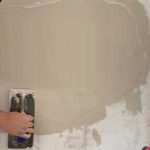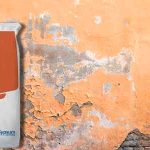In many older properties you will find lime plaster on walls. You might notice that your walls have started to deteriorate, as lime plaster can soften and weaken over time, causing it to fail.
If this is the case, you might consider applying a skim coat of plaster over the existing surface. However, for plaster to successfully bond, it needs a surface that is free from imperfections to provides the perfect key. This will create the ideal bond and will ensure that your plaster stays on the wall.
You can skim over lime plaster, but to complete a successful job, there are several things you will need to consider. The first is to check the condition of the walls. If they are crumbling and coming away from the wall, then it is not recommended to skim over.
If the condition of the walls is suitable, then it is recommended to over skim using a lime-based plaster. This will ensure that the skim coat and the existing plaster can work together, and the lime plaster maintains its natural breathability.
How do you skim over lime plaster?

If you’re looking to improve your existing lime plaster walls, because they are failing, or you simply want to create a better finish, you might choose to skim over the existing surface.
However, it is not just a case of applying modern gypsum plaster over the top of it. This is because they are both completely different products, that behave in different ways. As a result, they won’t usually work together, which will lead to problems.
Lime plaster breathes, and that means that it contains moisture. In contrast, gypsum plaster contains salt, which means that it attracts water. So, if you apply gypsum plaster, it will suck the moisture out of the lime plaster. This will eventually cause the lime plaster to fail and lose its bond with the sub surface. As a result, your new coat of plaster will come away from the wall with it.
Lime plaster is more expensive than gypsum plaster. So, if your budget doesn’t stretch to lime plaster there are some steps you can take to apply gypsum plaster:
- Apply stabiliser to the wall using a brush or roller and leave to dry
- Once dry, apply PVA
This will help to stabilise and seal the lime plaster, while the PVA will allow the gypsum plaster to bond. However, we should re-stress, this is not best practice, it is recommended to use lime plaster if you want a finish that will last.
Why does lime plaster crack and deteriorate?
Lime plaster is highly durable, but it can suffer from cracking and deterioration. This can cause your plaster to fail and come away from the surface. Therefore, it helps to understand why it cracks and deteriorates.
Deterioration can occur due to issues created during application, as well as problems that develop over time. Some of the main issues can be seen below:
- Over troweling during application – Over troweling can cause fat to come up to the surface of the plaster. This causes the mix to change, which can cause the plaster to shrink and crack
- Plaster mixed too wet – If the mix is made too wet, then this can cause it to become over-bulked. As lime dries, it reduces in volume, so too much water will cause problems with the drying process. Over time this may lead to the plaster deteriorating.
- Lack of moisture during application – If no water was applied to the subsurface before applying the lime plaster. This can cause the subsurface to suck moisture from new plaster. When this happens, it will cause the plaster to dry out too quickly, effecting the bond it makes with the sub surface.
- Heating and ventilation – If there are large increases or decreases in temperature, or is a lack of ventilation, this can result in plaster absorbing and releasing moisture too quickly. As a result, this can cause shrinkage and cracking.
- Excessive damp – As with most things, damp can cause issues. If penetrating damp enters, it can saturate the plaster and cause it to fail over time.
If you have lime plaster with cracks and areas that have deteriorated, it is probably time to consider repairing or replacing it.
When to repair and when to replace lime plaster?
Old lime plasters might be highly durable, but over time, they can suffer from damage, just like any other building material. Fortunately, it is often possible to repair damage, depending on the severity, enabling you to retain the look of the existing walls.
When it comes to repairing old lime plaster, you have two main options:
- Patch repair – If you have small cracks, then patch repairs will often do the job. You will need to determine whether you can achieve a smooth finish without the need to re-skim the entire surface.
- Re-skim – If the damage is not suitable for patch repairs, then you will need to consider re-skimming your walls. Again, you’ll need to make sure that the new materials adhere to the existing surface.
Should you find that the lime plaster has too much damage and is coming away from the walls, then it will need to be replaced. You’ll have to spend time removing the lime plaster which is a tedious and time-consuming job. However, by doing this, the walls will be taken back to the original surface. This will enable you to apply new plaster and achieve a much better-quality finish.
Conclusion
So, as you can see, it is possible to skim over lime plaster. However, you should follow the correct process before applying the new coat. This will ensure that the new plaster bonds to the existing surface and retains its durability.
If there is sufficient damage to the walls, the existing lime plaster should be removed. This will prevent the new plaster from coming away from the wall. However, if the damage is light and can be repaired, this is often the best option.
Finally, remember that it pays to take your time and follow the correct process. Over skimming lime plaster should nearly always be done with more lime plaster. This will ensure you achieve a successful finish that lasts.




